Interesting Detailed Analysis of 4GS Suspension
#1
Pole Position
Thread Starter
2013 Lexus GS 350 F Sport Suspension Walkaround
A Look Underneath the Fourth-Generation Lexus GS Sedan
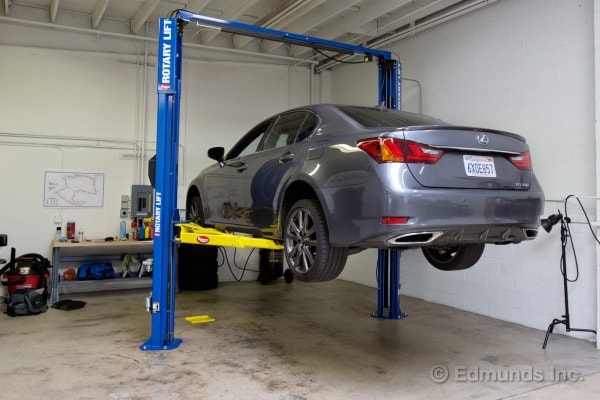
The rear-drive Lexus GS has evolved steadily since it first appeared in North America some 20 years ago as a 1993 model. In its original form it was essentially a four-door sport sedan variant of the Toyota Supra and Soarer coupes, right down to the 3.0-liter straight-6 power plant.
In 1998 the second generation arrived, and with it came an optional 4.0-liter V8 engine that was subsequently bumped to 4.3 liters after a couple of years. Then the third generation came in 2006 with a 3.0-liter V6 as the base offering instead of the inline-6. All-wheel drive, a hybrid version and an increase in the base V6 engine's displacement to 3.5 liters came next.
Our 2013 Lexus GS 350 long-termer represents the first year of the fourth generation of the GS line. Today's 3.5-liter base V6 makes 306 horsepower and delivers 23 mpg on the EPA combined cycle, some 6 hp and a full 5 mpg better than the optional hot rod 4.0-liter V8 did when it emerged in 1998.
During that same 15-year period the GS received significant structural safety enhancements, more standard equipment and a slight increase in size, but today's new base 2013 GS 350 weighs barely 100 pounds more than its 1998 GS 400 counterpart.
As time has passed, the suspension that underpins the smaller Lexus IS has come to resemble that of its GS big brother, meaning that anything we find on our 2013 Lexus GS 350 will likely show up underneath the 2014 Lexus IS when it breaks cover in June. With that in mind we hiked our 2013 GS F Sport up on our Rotary lift for a look around.
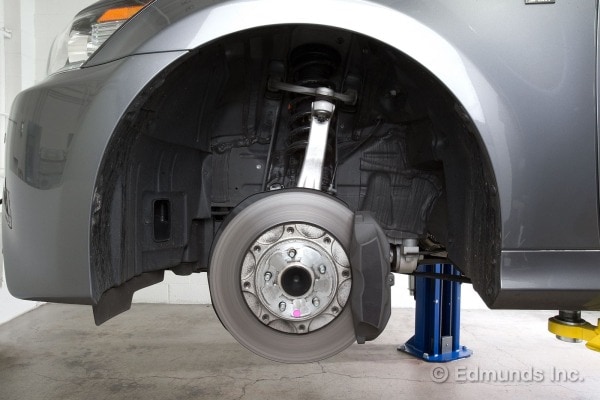
Since its debut, the Lexus GS has ridden on a double-wishbone front suspension with a high-mount upper arm. But don't take that to mean nothing has changed.
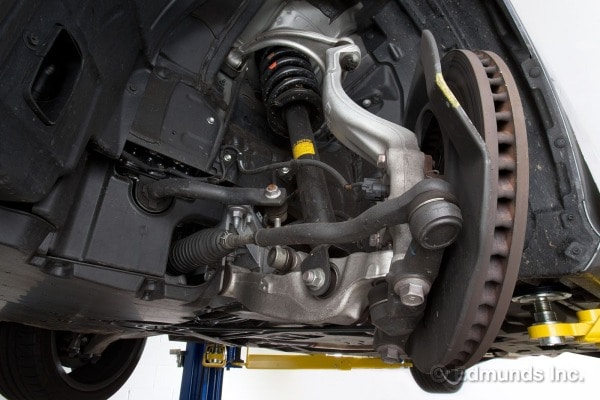
Most everything up here was iron and steel for the first two generations, but here on our 2013 GS 350 the upper control arm, lower control arm and knuckle are all made of aluminum.
Incidentally, the current Lexus IS looks a lot like the third-generation Lexus GS that just got replaced. Refer to the 2011 Lexus IS-F Suspension Walkaround if you want to get a sense of before and after.
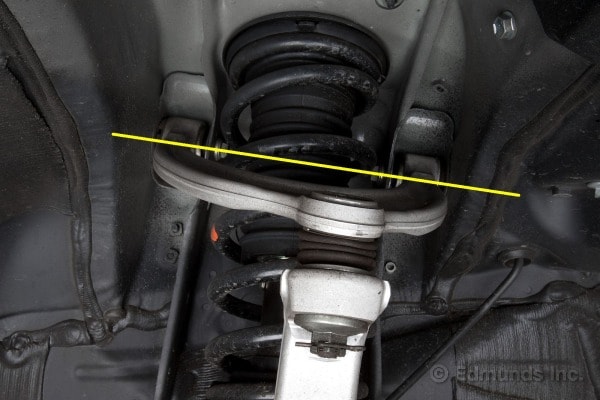
This year's high-mount upper arm suspension has been revised to alter its anti-lift characteristics, so it's likely that many of the hard point locations differ from last year.
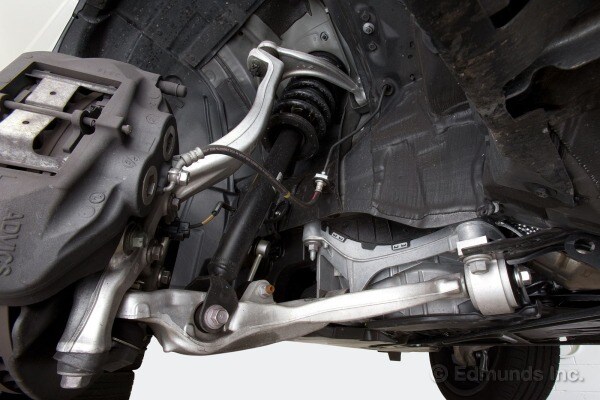
A base GS 350 has monotube coil-over shocks. And even though you can't see any external sensors, our F Sport has Adaptive Variable Suspension (AVS) in which the damping force self-adjusts depending on conditions. Two driver-selectable damping ranges are offered: one for Normal/Eco/Sport S and another for Sport S+.
The system isn't just about reading the road surface texture and optimizing ride comfort. Unlike the system seen on the IS-F walkaround, this one uses a central accelerometer pack instead of four distinct suspension height sensors. The system is linked to the wheel speed sensors, accelerator, steering and brakes to predictively respond to the driver's intent with asymmetrical damping to resist body roll, brake dive and acceleration squat.
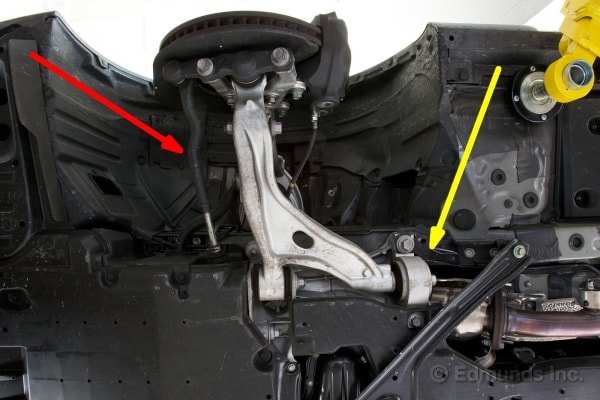
Last year the lower control arm (LCA) was made of steel, not forged aluminum as it is now. And this year's rear LCA bushing (yellow) has been enlarged, which allows a stiffer setting to achieve the same or better harshness performance.
The front-acting steering (red) represents no change from the outgoing third generation, but front-steer wasn't always the case because first- and second-generation GS sedans had rear-acting steering, presumably because of packaging issues associated with the straight-6 power plant they carried.
Whatever led to the change, today's front-steer allows a straighter steering shaft with less tortured U-joint angles, and those forward-mounted tie rods tend to deliver lateral compliance understeer instead of oversteer. Both attributes are desirable because they add up to more precision and control.
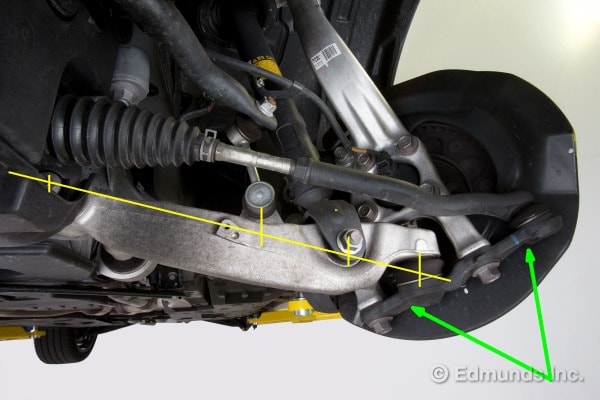
Even though the front-steer layout isn't new this year, and the bolt-on ball joint/steering arm (green) idea has been on the GS since the beginning, our new 2013 Lexus GS 350 does have some new tricks up its sleeve.
This time its electric power steering assist is delivered at the rack instead of the column. And our F Sport has an optional variable gear ratio steering (VGRS) device in the steering column that can add or subtract lock depending on dynamic conditions. The rack-and-pinion gears have a fixed ratio, but the VGRS module behind the steering wheel can under- or overdrive the driver's input to varying degrees, effectively altering the steering gear ratio between 12.0-to-1 and 10.3-to-1 (or 2.6 to 2.2 turns lock-to-lock) from the perspective of the driver's hands.
And just look at how much lock there is. Despite its size, the 2013 Lexus GS has one of the tightest turning circles in our current long-term fleet, as illustrated in a recent test.
Meanwhile, those yellow tick marks on the lower control arm highlight the apparent motion ratio of the stabilizer bar's drop-link and the coil-over spring/shock assembly. The former looks to be 0.6-to-1, and according to Lexus the 2013 GS stabilizer bar's arm ratio has been increased over last year. They also say the stabilizer bar itself is stiffer (but not by how much). Taken together, these two factors add up to more front roll stiffness.
For our part the 2013 Lexus GS corners flatter than those we remember from the past, and our test pilot was suitably impressed at the track.
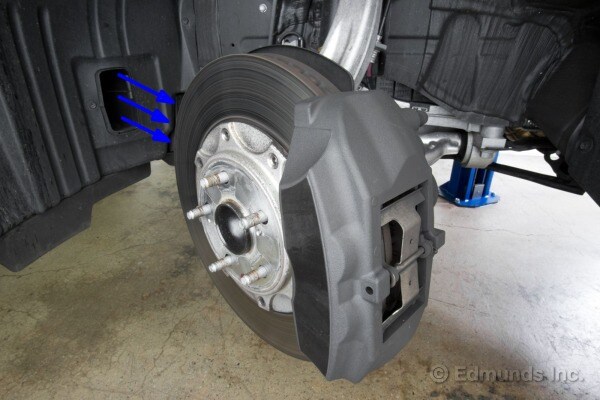
The F Sport GS has 14-inch two-piece front rotors and four-piston fixed brake calipers that are neither red (gasp!) nor sourced from Brembo. The brake pads within cover an area of 8.15 square inches, about 32 percent more than the standard 2013 GS front brakes, which grip smaller 13.1-inch rotors.
The functional cooling duct that shoots cool air at them isn't new this year, but the size of the duct has been significantly enlarged and the passage from the bumper is much more of a straight shot.
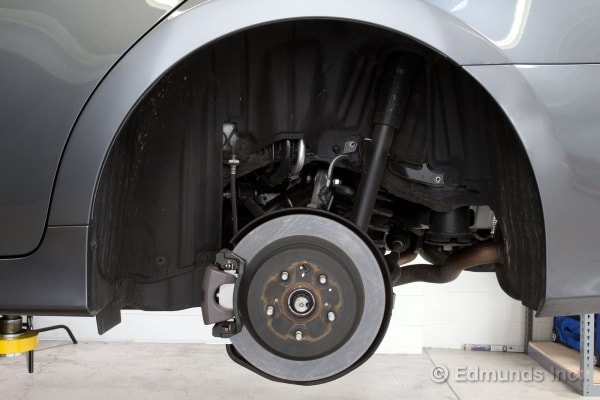
The rear half of the Lexus GS has always sat on a multilink of some description, but the description has often changed. This year is no different, and much of the difference can be glimpsed from this view.

Like last year, the top end is located by a pair of upper links arrayed in the rough shape of an upper A-arm (green).
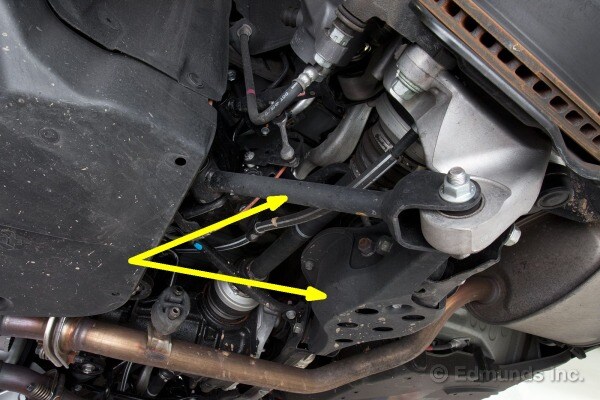
Two more links arrayed in much the same way do the honors down below.
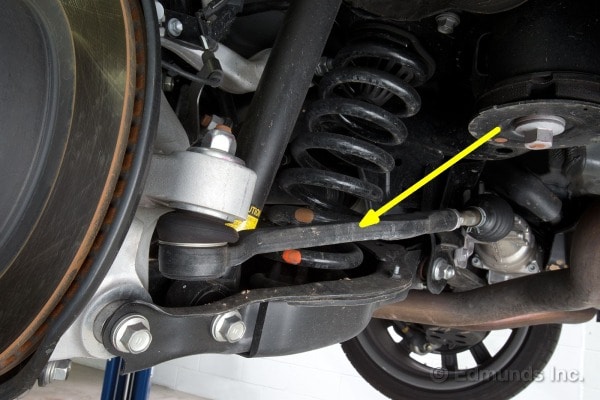
That long rear-mounted toe link is one of this year's biggest changes. Up till now all GS sedans have used a short stubby toe link mounted ahead of the axle centerline. Lexus says the new longer link reduces the magnitude of the rear toe change as the suspension strokes or compresses when loaded in corners.
Interestingly, this is precisely the opposite change from the one we recently saw on the 2013 SRT Viper. There may be 640 reasons for this, as the Viper has always been a sneeze away from inglorious oversteer. Perhaps SRT wanted a little more compliance or roll understeer to take the edge off, while Lexus went the other way in order to liven up the *** end of its very well-mannered machine.
But there is another reason for the rear-mounted toe link.
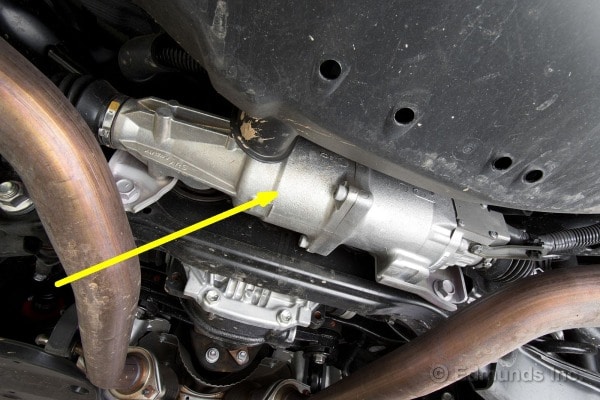
That reason is the new option fitted to our 2013 Lexus GS 350 F Sport: Dynamic Rear Steering (DRS). You can't put a steering rack like this ahead of the axle because that's where the driveshaft and differential reside. If Lexus engineers wanted a four-wheel-steering option, then the rack and its tie-rod links had to live out back.
The DRS steering rack is electronically actuated by a computer that is tied in to every other steering and suspension sensor and system. You can't feel it when it's working, but in rough terms the rack turns the rear wheels in "opposite phase" with the fronts to enhance maneuverability below 50 mph and moves them "in phase" with the fronts at higher speeds to improve straight-line stability.
There's more to the algorithm than mere speed, of course, but you get the idea.
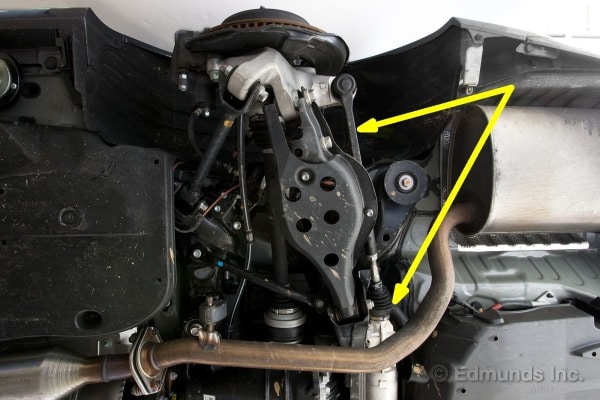
GS sedans without the DRS option, which is most of them, get lightweight forged aluminum toe links instead of these movable tie rods.
Anyone who's ever driven a forklift or tried to back up a car at speed knows a little rear steering goes a long way, and in keeping with that fact, the DRS system moves the rear wheels no more than 1.5 degrees, which works out to the width of the fingernail on your index finger.

But the rear-mounted toe link isn't the only news. This year Lexus abandoned the long-standing use of rear coil-overs on the GS in favor of springs and shocks that are mounted separately.
Why? Coil-overs are fat all the way to the upper mounting point, which eats into trunk space on the one side and tire and wheel space on the other. This way the slender shock body (yellow) is the only part that runs betwixt the trunk and the rear tires, while the spring (green) sits out of the way beneath the floor.
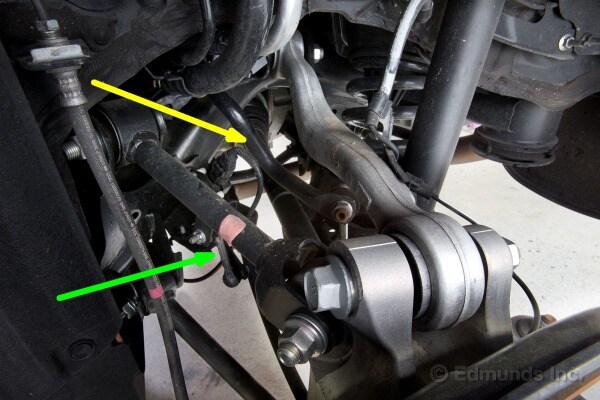
Yeah, there's a rear stabilizer bar (yellow) buried in there. There's a rear suspension height sensor hanging around, too, but because there isn't a similar one in front I suspect its main job is to give instructions to the leveling system for the bi-xenon HID headlights.
What I haven't seen, however, is any sort of camber adjustment eccentrics. It seems as if toe-in is the only available adjustment.

All 2013 Lexus GS sedans, F Sport or otherwise, get the same rear brakes consisting of a single-piston sliding caliper and 12.2-inch ventilated rotors.
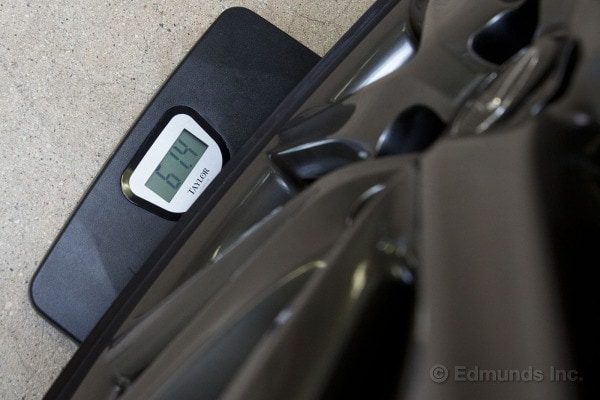
All 2013 Lexus GS sedans get same-size front and rear wheels and tires. All except our rear-drive F Sport, that is. It's the only one that gets wider rear wheels and tires in the form of 19-by-9-inch wheels and 265/35R19 three-season tires that have a combined weight of 61.4 pounds. The 235/40R19 front tires ride on 19-by-8-inch rims and weigh about 5 pounds less.
From what we can tell so far, the package is well-reasoned and works very well. This generation of Lexus GS seems to be the best yet. And if the upcoming 2014 Lexus IS benefits similarly from the changes we see here, as we suspect it will, then the more affordable and sporty end of the Lexus spectrum may soon get very interesting indeed.
A Look Underneath the Fourth-Generation Lexus GS Sedan

The rear-drive Lexus GS has evolved steadily since it first appeared in North America some 20 years ago as a 1993 model. In its original form it was essentially a four-door sport sedan variant of the Toyota Supra and Soarer coupes, right down to the 3.0-liter straight-6 power plant.
In 1998 the second generation arrived, and with it came an optional 4.0-liter V8 engine that was subsequently bumped to 4.3 liters after a couple of years. Then the third generation came in 2006 with a 3.0-liter V6 as the base offering instead of the inline-6. All-wheel drive, a hybrid version and an increase in the base V6 engine's displacement to 3.5 liters came next.
Our 2013 Lexus GS 350 long-termer represents the first year of the fourth generation of the GS line. Today's 3.5-liter base V6 makes 306 horsepower and delivers 23 mpg on the EPA combined cycle, some 6 hp and a full 5 mpg better than the optional hot rod 4.0-liter V8 did when it emerged in 1998.
During that same 15-year period the GS received significant structural safety enhancements, more standard equipment and a slight increase in size, but today's new base 2013 GS 350 weighs barely 100 pounds more than its 1998 GS 400 counterpart.
As time has passed, the suspension that underpins the smaller Lexus IS has come to resemble that of its GS big brother, meaning that anything we find on our 2013 Lexus GS 350 will likely show up underneath the 2014 Lexus IS when it breaks cover in June. With that in mind we hiked our 2013 GS F Sport up on our Rotary lift for a look around.

Since its debut, the Lexus GS has ridden on a double-wishbone front suspension with a high-mount upper arm. But don't take that to mean nothing has changed.

Most everything up here was iron and steel for the first two generations, but here on our 2013 GS 350 the upper control arm, lower control arm and knuckle are all made of aluminum.
Incidentally, the current Lexus IS looks a lot like the third-generation Lexus GS that just got replaced. Refer to the 2011 Lexus IS-F Suspension Walkaround if you want to get a sense of before and after.

This year's high-mount upper arm suspension has been revised to alter its anti-lift characteristics, so it's likely that many of the hard point locations differ from last year.

A base GS 350 has monotube coil-over shocks. And even though you can't see any external sensors, our F Sport has Adaptive Variable Suspension (AVS) in which the damping force self-adjusts depending on conditions. Two driver-selectable damping ranges are offered: one for Normal/Eco/Sport S and another for Sport S+.
The system isn't just about reading the road surface texture and optimizing ride comfort. Unlike the system seen on the IS-F walkaround, this one uses a central accelerometer pack instead of four distinct suspension height sensors. The system is linked to the wheel speed sensors, accelerator, steering and brakes to predictively respond to the driver's intent with asymmetrical damping to resist body roll, brake dive and acceleration squat.

Last year the lower control arm (LCA) was made of steel, not forged aluminum as it is now. And this year's rear LCA bushing (yellow) has been enlarged, which allows a stiffer setting to achieve the same or better harshness performance.
The front-acting steering (red) represents no change from the outgoing third generation, but front-steer wasn't always the case because first- and second-generation GS sedans had rear-acting steering, presumably because of packaging issues associated with the straight-6 power plant they carried.
Whatever led to the change, today's front-steer allows a straighter steering shaft with less tortured U-joint angles, and those forward-mounted tie rods tend to deliver lateral compliance understeer instead of oversteer. Both attributes are desirable because they add up to more precision and control.

Even though the front-steer layout isn't new this year, and the bolt-on ball joint/steering arm (green) idea has been on the GS since the beginning, our new 2013 Lexus GS 350 does have some new tricks up its sleeve.
This time its electric power steering assist is delivered at the rack instead of the column. And our F Sport has an optional variable gear ratio steering (VGRS) device in the steering column that can add or subtract lock depending on dynamic conditions. The rack-and-pinion gears have a fixed ratio, but the VGRS module behind the steering wheel can under- or overdrive the driver's input to varying degrees, effectively altering the steering gear ratio between 12.0-to-1 and 10.3-to-1 (or 2.6 to 2.2 turns lock-to-lock) from the perspective of the driver's hands.
And just look at how much lock there is. Despite its size, the 2013 Lexus GS has one of the tightest turning circles in our current long-term fleet, as illustrated in a recent test.
Meanwhile, those yellow tick marks on the lower control arm highlight the apparent motion ratio of the stabilizer bar's drop-link and the coil-over spring/shock assembly. The former looks to be 0.6-to-1, and according to Lexus the 2013 GS stabilizer bar's arm ratio has been increased over last year. They also say the stabilizer bar itself is stiffer (but not by how much). Taken together, these two factors add up to more front roll stiffness.
For our part the 2013 Lexus GS corners flatter than those we remember from the past, and our test pilot was suitably impressed at the track.

The F Sport GS has 14-inch two-piece front rotors and four-piston fixed brake calipers that are neither red (gasp!) nor sourced from Brembo. The brake pads within cover an area of 8.15 square inches, about 32 percent more than the standard 2013 GS front brakes, which grip smaller 13.1-inch rotors.
The functional cooling duct that shoots cool air at them isn't new this year, but the size of the duct has been significantly enlarged and the passage from the bumper is much more of a straight shot.

The rear half of the Lexus GS has always sat on a multilink of some description, but the description has often changed. This year is no different, and much of the difference can be glimpsed from this view.

Like last year, the top end is located by a pair of upper links arrayed in the rough shape of an upper A-arm (green).

Two more links arrayed in much the same way do the honors down below.

That long rear-mounted toe link is one of this year's biggest changes. Up till now all GS sedans have used a short stubby toe link mounted ahead of the axle centerline. Lexus says the new longer link reduces the magnitude of the rear toe change as the suspension strokes or compresses when loaded in corners.
Interestingly, this is precisely the opposite change from the one we recently saw on the 2013 SRT Viper. There may be 640 reasons for this, as the Viper has always been a sneeze away from inglorious oversteer. Perhaps SRT wanted a little more compliance or roll understeer to take the edge off, while Lexus went the other way in order to liven up the *** end of its very well-mannered machine.
But there is another reason for the rear-mounted toe link.

That reason is the new option fitted to our 2013 Lexus GS 350 F Sport: Dynamic Rear Steering (DRS). You can't put a steering rack like this ahead of the axle because that's where the driveshaft and differential reside. If Lexus engineers wanted a four-wheel-steering option, then the rack and its tie-rod links had to live out back.
The DRS steering rack is electronically actuated by a computer that is tied in to every other steering and suspension sensor and system. You can't feel it when it's working, but in rough terms the rack turns the rear wheels in "opposite phase" with the fronts to enhance maneuverability below 50 mph and moves them "in phase" with the fronts at higher speeds to improve straight-line stability.
There's more to the algorithm than mere speed, of course, but you get the idea.

GS sedans without the DRS option, which is most of them, get lightweight forged aluminum toe links instead of these movable tie rods.
Anyone who's ever driven a forklift or tried to back up a car at speed knows a little rear steering goes a long way, and in keeping with that fact, the DRS system moves the rear wheels no more than 1.5 degrees, which works out to the width of the fingernail on your index finger.

But the rear-mounted toe link isn't the only news. This year Lexus abandoned the long-standing use of rear coil-overs on the GS in favor of springs and shocks that are mounted separately.
Why? Coil-overs are fat all the way to the upper mounting point, which eats into trunk space on the one side and tire and wheel space on the other. This way the slender shock body (yellow) is the only part that runs betwixt the trunk and the rear tires, while the spring (green) sits out of the way beneath the floor.

Yeah, there's a rear stabilizer bar (yellow) buried in there. There's a rear suspension height sensor hanging around, too, but because there isn't a similar one in front I suspect its main job is to give instructions to the leveling system for the bi-xenon HID headlights.
What I haven't seen, however, is any sort of camber adjustment eccentrics. It seems as if toe-in is the only available adjustment.

All 2013 Lexus GS sedans, F Sport or otherwise, get the same rear brakes consisting of a single-piston sliding caliper and 12.2-inch ventilated rotors.

All 2013 Lexus GS sedans get same-size front and rear wheels and tires. All except our rear-drive F Sport, that is. It's the only one that gets wider rear wheels and tires in the form of 19-by-9-inch wheels and 265/35R19 three-season tires that have a combined weight of 61.4 pounds. The 235/40R19 front tires ride on 19-by-8-inch rims and weigh about 5 pounds less.
From what we can tell so far, the package is well-reasoned and works very well. This generation of Lexus GS seems to be the best yet. And if the upcoming 2014 Lexus IS benefits similarly from the changes we see here, as we suspect it will, then the more affordable and sporty end of the Lexus spectrum may soon get very interesting indeed.
Link : http://www.edmunds.com/car-reviews/t...alkaround.html
#2
Lexus Champion
iTrader: (10)
It looks like spacers can be installed to get a free drop. Not sure how safe it would be with aluminum parts though.

I don't know how you would put a spacer on here though. It wouldn't be reliable and it'll move. The rear is gonna be a ***** to mod and also keep it stiff. You might be able to adjust camber with the 2nd pic too.



I don't know how you would put a spacer on here though. It wouldn't be reliable and it'll move. The rear is gonna be a ***** to mod and also keep it stiff. You might be able to adjust camber with the 2nd pic too.


Last edited by sam430; 02-14-13 at 10:07 PM.
Trending Topics
#11
Very good photos from a very clean underside, because in real life, under the mud guard, it is mostly black [dark brown], so it is much more difficult to visualize suspension component parts, and the Manufacturer's Workshop Manuals only provide schematic diagrams, with no colorful photos like these at all.
I will bookmark this thread, in case I ever have to look back at these photos again...
I will bookmark this thread, in case I ever have to look back at these photos again...
#13
Lexus Fanatic
iTrader: (33)
It looks like spacers can be installed to get a free drop. Not sure how safe it would be with aluminum parts though.

I don't know how you would put a spacer on here though. It wouldn't be reliable and it'll move. The rear is gonna be a ***** to mod and also keep it stiff. You might be able to adjust camber with the 2nd pic too.

I don't know how you would put a spacer on here though. It wouldn't be reliable and it'll move. The rear is gonna be a ***** to mod and also keep it stiff. You might be able to adjust camber with the 2nd pic too.
Good catch

If I recall aren't the rca blocks aluminum? I doubt you would see any issues and it has to be a high grade aluminum given all the stress.
#14
Pole Position
Thread Starter
One thing I found impressive is how sophisticated the Adaptive Variable Suspension( AVS) is :
The implication is that there's a central "brain" that can adjust the shock stiffness at each wheel in a co-ordinated manner to simulate an active sway bar effect when cornering. This has three benefits :
1) The engineers can dispense with an overly thick sway bar which would affect ride comfort adversely without compromising on flat handling/cornering.
2) Less complicated electronics and moving parts required for an actual active sway bar -- less things to go wrong.
3) Less massive sway bars ----> weight savings.
The system isn't just about reading the road surface texture and optimizing ride comfort. Unlike the system seen on the IS-F walkaround, this one uses a central accelerometer pack instead of four distinct suspension height sensors. The system is linked to the wheel speed sensors, accelerator, steering and brakes to predictively respond to the driver's intent with asymmetrical damping to resist body roll, brake dive and acceleration squat.
1) The engineers can dispense with an overly thick sway bar which would affect ride comfort adversely without compromising on flat handling/cornering.
2) Less complicated electronics and moving parts required for an actual active sway bar -- less things to go wrong.
3) Less massive sway bars ----> weight savings.




